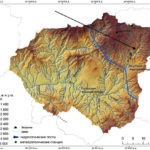UDK 556.535.3
Margayan V.G., Gaidukova E.V., Azizyan L.V., Myakisheva N.V. HYDROECOLOGICAL CONSEQUENCES OF CLIMATE CHANGES IN THE WATER REGIME OF SPRING FLOOD IN THE UPPER REACHES BASIN OF THE ARPA RIVER // Arid ecosystems. 2022. V.28. № 2 (91). P. 3-12. | PDF
The article discusses the long-term trends in river flow change of spring floods and hydroecological and water management consequences of climate change in the upper river Arpa. The study used data on average daily water discharge and water temperature in the river section Jermuk of the Arpa River, also data on the main meteorological elements at the Jermuk meteorological station located in the upper reaches basin of the Arpa river.
It is presented that one of the most important characteristics of the flood is maximum water discharge during the spring flood. Absolute maximum discharges vary by range from 8.26 to 199 m3/s, average maximum flow rates — from 1.86 to 116 m3/s.
Discussed and evaluated the interannual change in the dates of the beginning, end, duration and volume of spring flood runoff, also temperatures surface layer of air and atmospheric precipitation for December-February and for April-June, maximum water reserve as snow, water temperature for April-June.
It is shown that over the past 28 years, the volume of floods and their duration diminished, the dates are shifted towards earlier dates, the maximum water discharge during the flood period decreases. It was revealed as well that winter and spring-summer (for April-June) average air temperatures increase, winter precipitation increases, the maximum supply of water in the snow decreases. As a consequence of modern changes in the hydrological regime of spring floods numerous hydroecological and water management problems are
It is noted that interannual fluctuations show the clearly visible fracture in the course of average monthly volumes of spring floods at the beginning-middle of 1990-ies after which the period of significant and stable lowering of discharges began. Typically maximum values water (as well as air) temperatures are observed in July – August, and minimum — in December – January (air temperature) and in January (water temperature). Average monthly water temperatures in winter season (December – March) at the Jermuk section of the Arpa river are positive, negative temperatures are observed rarely, in single winters with severe frosts. Negative air temperature values are recorded mainly from the second half of November and last until the end of March. The average water temperature on the river Arpa — Jermuk settlement for the period April-June is 4.9°C, average annual temperature of air and soil surface at the Jermuk meteorological station – 8.6°C and 11.7°C, respectively.
It is presented that one of the most important characteristics of the flood is maximum water discharge during the spring flood. The value and date of the onset of the maximum water discharge correlate with the amount of snow reserves, the intensity of the inflow of warm air and precipitation. Absolute maximum costs vary by range from 8.26 to 199 m3/s, average maximum flow rates – from 1.86 to 116 m3/s.
It is noted that present climatic changes lead to significant degradation of high water as phases of the water regime in the upper part of the Arpa River basin: increase in winter season surface air temperature is the main reason for the decrease of water content of spring in the upper reaches of the river Arpa.
Correlations between the values of the volumes of the spring floods in the upper reaches of the river Arpa, calculated from April to June and from the beginning floods before its end are presented in the paper. This dependency can be used to estimating, calculating, and also checking the volume of spring floods, if we have the data of the volume runoff for April – June.
Keywords: Arpa river, Key words: spring flood, air and water temperatures, precipitation, maximum water reserve in snow, interannual variation, hydroecological and water management problems, the upper reaches of the Arpa River.
Financing. The study was carried out with the financial support of the Committee of Science of the Republic of Armenia and the Russian Foundation for Basic Research (RFBR) within the framework of the joint scientific program 20RF-039 «Short-term probabilistic forecast of river flow during the spring flood» and No. 20-55-05006\20.
DOI: 10.24412/1993-3916-2022-2-3-12











